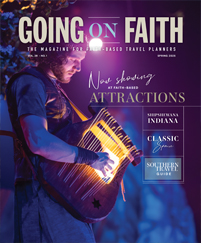Industrial Innovations
Milwaukee has a long history of industrial prowess, and some of the great commercial ventures that started there are household names today. Groups visiting the city can tour a variety of historic sites and museums dedicated to its most famous businesses.
Every group that visits the city should plan a stop at the Harley-Davidson Museum, which details the history of the motorcycle manufacturer that has become an icon of American pride.
“Harley-Davidson started here in 1903,” Casey said. “If you’re a motorcycle enthusiast, it’s your mecca. But even if you’re not, there’s so much in the museum that’s interesting to everyone. You see the very first Harley bikes and learn how they were adapted for different purposes during the first and second world wars. There’s also a great exhibit of custom bikes, covered with things like American flags and sequins.”
One of the most interesting items on display is the “Tsunami Bike,” a Harley-Davidson lost in the 2011 tsunami in Japan that washed up on the shore of western Canada.
Another Milwaukee name known throughout the country is Pabst. Capt. Frederick Pabst made a name for himself as a brewer in the late 19th century, and groups can now tour both his Milwaukee mansion and his original brewery.
The Pabst mansion was built in the 1890s and is now open for tours.
“You learn about the house and all of the rich furnishings and artwork,” Casey said. “But it also incorporates a lot of Milwaukee history. The history of the breweries reflects the history of Milwaukee and our early industrial origins.”
A great complement to the mansion is a tour of the original Pabst brewery complex, which has been purchased by a local entrepreneur and relaunched as Best Place, a museum and events venue.
“The owner gives tours and lectures on Milwaukee’s beer history,” Casey said. “He has a slide show that features old-time beer commercials and a retail shop that sells lots of retro beer items.”
Art on Display
In addition to its industrial heritage, Milwaukee also enjoys a thriving arts culture. There are various places around the city where groups can see fine art. One of the most distinctive is the Pfister Hotel, a century-old luxury hotel downtown that has amassed an impressive collection of paintings.
“It’s the legendary grand dame hotel of Milwaukee,” Casey said. “It has the largest collection of Victorian art in a hotel in the country. Groups can eat lunch there and take tours to see the art.”
Tours are led by artists in residence who serve yearlong terms showing visitors around and creating contemporary artwork in the on-site studio and gallery.
And no group should leave Milwaukee without stopping to see its most iconic structure: the Milwaukee Art Museum. The institution has existed for more than 120 years and owns more than 20,000 works of art from around the world. But the museum came to international prominence in 2001 with the opening of its Quadracci Pavilion, a striking modern facility designed by renowned Spanish architect Santiago Calatrava.
“The museum has wings that literally open and close twice a day every day,” Casey said. “They have the span of a 747 airplane. It’s really our greatest landmark.”
Groups can plan to arrive at the museum in the morning to watch the 10 o’clock unfolding of the wings, then spend a couple of hours exploring the atrium and the museum galleries. Lunch at the museum makes a great way to wrap up a tour of Milwaukee.
“There’s a lovely restaurant there at the museum,” Casey said. “The chef creates dishes with themes that correspond to the special exhibits. He even mimics the colors and textures of the artwork on the plate.”
Visit Milwaukee
800-554-1448










